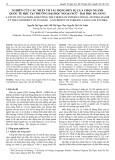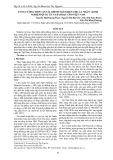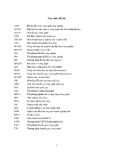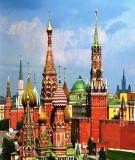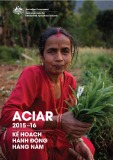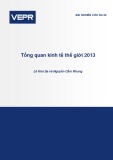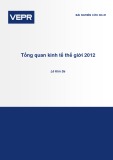
Chapter 3
Interdependence and the Gains from Trade
TRUE/FALSE
1. In most countries today, many goods and services consumed are imported from abroad, and many goods and
services produced are exported to foreign customers.
ANS: T DIF: 1 REF: 3-0
NAT: Analytic LOC: Gains from trade, specialization and trade
TOP: Trade MSC: Definitional
2. Interdependence among individuals and interdependence among nations are both based on the gains from
trade.
ANS: T DIF: 2 REF: 3-0
NAT: Analytic LOC: Gains from trade, specialization and trade
TOP: Gains from trade MSC: Interpretive
3. If a person chooses self-sufficiency, then she can only consume what she produces.
ANS: T DIF: 1 REF: 3-1
NAT: Analytic LOC: The study of economics and definitions of economics
TOP: Self-sufficiency MSC: Definitional
4. If Wrex can produce more math problems per hour and more book reports per hour than Maxine can, then
Wrex cannot gain from trading math problems and book reports with Maxine.
ANS: F DIF: 2 REF: 3-1
NAT: Analytic LOC: Gains from trade, specialization and trade
TOP: Gains from trade MSC: Applicative
5. It is possible for the U.S. to gain from trade with Germany even if it takes U.S. workers fewer hours to
produce every good than it takes German workers.
ANS: T DIF: 2 REF: 3-1
NAT: Analytic LOC: Gains from trade, specialization and trade
TOP: Gains from trade MSC: Applicative
6. A production possibilities frontier is a graph that shows the combination of outputs that an economy should
produce.
ANS: F DIF: 2 REF: 3-1
NAT: Analytic LOC: Understanding and applying economic models
TOP: Production possibilities frontier MSC: Interpretive
7. Production possibilities frontiers cannot be used to illustrate tradeoffs.
ANS: F DIF: 1 REF: 3-1
NAT: Analytic LOC: Understanding and applying economic models
TOP: Production possibilities frontier MSC: Definitional
8. An economy can produce at any point on or inside its production possibilities frontier, but it cannot produce at
points outside its production possibilities frontier.
ANS: T DIF: 2 REF: 3-1
NAT: Analytic LOC: Understanding and applying economic models
TOP: Production possibilities frontier MSC: Interpretive
9. Trade allows a country to consume outside its production possibilities frontier.
ANS: T DIF: 2 REF: 3-1
NAT: Analytic LOC: Understanding and applying economic models
TOP: Production possibilities frontier | Trade MSC: Interpretive
128

129 Chapter 3 /Interdependence and the Gains from Trade
10. Opportunity cost refers to how many inputs a producer requires to produce a good.
ANS: F DIF: 1 REF: 3-2
NAT: Analytic LOC: Scarcity, tradeoffs, and opportunity cost
TOP: Opportunity cost MSC: Definitional
11. Opportunity cost measures the trade-off between two goods that each producer faces.
ANS: T DIF: 1 REF: 3-2
NAT: Analytic LOC: Scarcity, tradeoffs, and opportunity cost
TOP: Opportunity cost MSC: Definitional
12. For a country producing two goods, the opportunity cost of one good will be the inverse of the opportunity
cost of the other good.
ANS: T DIF: 2 REF: 3-2
NAT: Analytic LOC: Scarcity, tradeoffs, and opportunity cost
TOP: Opportunity cost MSC: Interpretive
13. Henry can make a bird house in 3 hours and he can make a bird feeder in 1 hour. The opportunity cost to
Henry of making a bird house is 1/3 bird feeder.
ANS: F DIF: 2 REF: 3-2
NAT: Analytic LOC: Scarcity, tradeoffs, and opportunity cost
TOP: Opportunity cost MSC: Applicative
14. Suppose that in one hour Dewey can produce either 10 bushels of corn or 20 yards of cloth. Then Dewey’s
opportunity cost of producing one bushel of corn is 1/2 yard of cloth.
ANS: F DIF: 2 REF: 3-2
NAT: Analytic LOC: Scarcity, tradeoffs, and opportunity cost
TOP: Opportunity cost MSC: Applicative
15. Jake can complete an oil change in 45 minutes and he can write a poem in 90 minutes. Ming-la can complete
an oil change in 30 minutes and she can write a poem in 90 minutes. Jake's opportunity cost of writing a poem
is lower than Ming-la's opportunity cost of writing a poem.
ANS: T DIF: 2 REF: 3-2
NAT: Analytic LOC: Scarcity, tradeoffs, and opportunity cost
TOP: Opportunity cost MSC: Applicative
16. Harry is a computer company executive, earning $200 per hour managing the company and promoting its
products. His daughter Quinn is a high school student, earning $6 per hour helping her grandmother on the
farm. Harry's computer is broken. He can repair it himself in one hour. Quinn can repair it in 10 hours.
Harry’s opportunity cost of repairing the computer is lower than Quinn’s.
ANS: F DIF: 2 REF: 3-2
NAT: Analytic LOC: Scarcity, tradeoffs, and opportunity cost
TOP: Opportunity cost MSC: Applicative
17. If one producer has the absolute advantage in the production of all goods, then that same producer will have
the comparative advantage in the production of all goods as well.
ANS: F DIF: 2 REF: 3-2
NAT: Analytic LOC: Gains from trade, specialization and trade
TOP: Absolute advantage | Comparative advantage MSC: Interpretive
18. If a country has the comparative advantage in producing a product, then that country must also have the
absolute advantage in producing that product.
ANS: F DIF: 2 REF: 3-2
NAT: Analytic LOC: Gains from trade, specialization and trade
TOP: Absolute advantage | Comparative advantage MSC: Interpretive

Chapter 3 /Interdependence and the Gains from Trade 130
19. In an economy consisting of two people producing two goods, it is possible for one person to have the
absolute advantage and the comparative advantage in both goods.
ANS: F DIF: 2 REF: 3-2
NAT: Analytic LOC: Gains from trade, specialization and trade
TOP: Absolute advantage | Comparative advantage MSC: Interpretive
20. If one producer is able to produce a good at a lower opportunity cost than some other producer, then the
producer with the lower opportunity cost is said to have an absolute advantage in the production of that good.
ANS: F DIF: 1 REF: 3-2
NAT: Analytic LOC: Gains from trade, specialization and trade
TOP: Comparative advantage MSC: Definitional
21. Unless two people who are producing two goods have exactly the same opportunity costs, then one person will
have a comparative advantage in one good, and the other person will have a comparative advantage in the
other good.
ANS: T DIF: 2 REF: 3-2
NAT: Analytic LOC: Gains from trade, specialization and trade
TOP: Comparative advantage MSC: Interpretive
22. Zora can produce 4 quilts in a week and she can produce 1 corporate website in a week. Lou can produce 9
quilts in a week and he can produce 2 corporate websites in a week. Zora has the comparative advantage in
quilts and the absolute advantage in neither good, while Lou has the comparative advantage in corporate
websites and the absolute advantage in both goods.
ANS: F DIF: 2 REF: 3-2
NAT: Analytic LOC: Gains from trade, specialization and trade
TOP: Absolute advantage | Comparative advantage MSC: Applicative
23. Timmy can edit 2 pages in one minute and he can type 80 words in one minute. Olivia can edit 1 page in one
minute and she can type 100 words in one minute. Timmy has an absolute advantage and a comparative
advantage in editing, while Olivia has an absolute advantage and a comparative advantage in typing.
ANS: T DIF: 2 REF: 3-2
NAT: Analytic LOC: Gains from trade, specialization and trade
TOP: Absolute advantage | Comparative advantage MSC: Applicative
24. Suppose Hank and Tony can both produce corn. If Hank’s opportunity cost of producing a bushel of corn is 2
bushels of soybeans and Tony’s opportunity cost of producing a bushel of corn is 3 bushels of soybeans, then
Hank has the comparative advantage in the production of corn.
ANS: T DIF: 2 REF: 3-2
NAT: Analytic LOC: Gains from trade, specialization and trade
TOP: Comparative advantage MSC: Applicative
25. It takes Anne 3 hours to make a pie and 4 hours to make a shirt. It takes Mary 2 hours to make a pie and 5
hours to make a shirt. Anne should specialize in making shirts and Mary should specialize in making pies,
and they should trade.
ANS: T DIF: 2 REF: 3-2
NAT: Analytic LOC: Gains from trade, specialization and trade
TOP: Specialization MSC: Applicative
26. The principle of comparative advantage states that, regardless of the price at which trade takes place, everyone
will benefit from trade if they specialize in the production of the good for which they have a comparative
advantage.
ANS: F DIF: 2 REF: 3-2
NAT: Analytic LOC: Gains from trade, specialization and trade
TOP: Comparative advantage MSC: Interpretive

131 Chapter 3 /Interdependence and the Gains from Trade
27. The gains from specialization and trade are based on absolute advantage.
ANS: F DIF: 1 REF: 3-2
NAT: Analytic LOC: Gains from trade, specialization and trade
TOP: Gains from trade MSC: Definitional
28. Trade can benefit everyone in society because it allows people to specialize in activities in which they have a
comparative advantage.
ANS: T DIF: 1 REF: 3-2
NAT: Analytic LOC: Gains from trade, specialization and trade
TOP: Gains from trade MSC: Definitional
29. Two countries can achieve gains from trade even if one country has an absolute advantage in the production of
both goods.
ANS: T DIF: 2 REF: 3-2
NAT: Analytic LOC: Gains from trade, specialization and trade
TOP: Gains from trade MSC: Interpretive
30. It takes Ross 6 hours to produce a bushel of corn and 2 hours to wash and polish a car. It takes Courtney 6
hours to produce a bushel of corn and 1 hour to wash and polish a car. Courtney and Ross cannot gain from
specialization and trade, since it takes each of them 6 hours to produce 1 bushel of corn.
ANS: F DIF: 2 REF: 3-2
NAT: Analytic LOC: Gains from trade, specialization and trade
TOP: Gains from trade MSC: Applicative
31. Differences in opportunity cost allow for gains from trade.
ANS: T DIF: 2 REF: 3-2
NAT: Analytic LOC: Gains from trade, specialization and trade
TOP: Gains from trade MSC: Interpretive
32. As long as two people have different opportunity costs, each can gain from trade with the other, since trade
allows each person to obtain a good at a price lower than his or her opportunity cost.
ANS: T DIF: 2 REF: 3-2
NAT: Analytic LOC: Gains from trade, specialization and trade
TOP: Gains from trade MSC: Interpretive
33. Trade allows a person to obtain goods at prices that are less than that person's opportunity cost because each
person specializes in the activity for which he or she has the lower opportunity cost.
ANS: T DIF: 2 REF: 3-2
NAT: Analytic LOC: Gains from trade, specialization and trade
TOP: Gains from trade MSC: Interpretive
34. When each person specializes in producing the good in which he or she has a comparative advantage, each
person can gain from trade but total production in the economy is unchanged.
ANS: F DIF: 2 REF: 3-2
NAT: Analytic LOC: Gains from trade, specialization and trade
TOP: Gains from trade MSC: Interpretive
35. For both parties to gain from trade, the price at which they trade must lie exactly in the middle of the two
opportunity costs.
ANS: F DIF: 2 REF: 3-2
NAT: Analytic LOC: Gains from trade, specialization and trade
TOP: Gains from trade MSC: Interpretive
36. Adam Smith was the author of the 1776 book An Inquiry into the Nature and Causes of the Wealth of Nations.
ANS: T DIF: 1 REF: 3-2
NAT: Analytic LOC: The study of economics and definitions of economics
TOP: Economists MSC: Definitional

Chapter 3 /Interdependence and the Gains from Trade 132
37. David Ricardo was the author of the 1817 book Principles of Political Economy and Taxation.
ANS: T DIF: 1 REF: 3-2
NAT: Analytic LOC: The study of economics and definitions of economics
TOP: Economists MSC: Definitional
38. Adam Smith wrote that a person should never attempt to make at home what it will cost him more to make
than to buy.
ANS: T DIF: 1 REF: 3-2
NAT: Analytic LOC: The study of economics and definitions of economics
TOP: Economists MSC: Definitional
39. Adam Smith developed the theory of comparative advantage as we know it today.
ANS: F DIF: 1 REF: 3-2
NAT: Analytic LOC: The study of economics and definitions of economics
TOP: Economists | Comparative advantage MSC: Definitional
40. Goods produced abroad and sold domestically are called exports and goods produced domestically and sold
abroad are called imports.
ANS: F DIF: 1 REF: 3-3
NAT: Analytic LOC: The study of economics and definitions of economics
TOP: Exports | Imports MSC: Definitional
41. International trade may make some individuals in a nation better off, while other individuals are made worse
off.
ANS: T DIF: 2 REF: 3-3
NAT: Analytic LOC: Gains from trade, specialization and trade
TOP: Gains from trade MSC: Interpretive
42. For international trade to benefit a country, it must benefit all citizens of that country.
ANS: F DIF: 2 REF: 3-3
NAT: Analytic LOC: Gains from trade, specialization and trade
TOP: Gains from trade MSC: Interpretive
43. Some countries win in international trade, while other countries lose.
ANS: F DIF: 2 REF: 3-3
NAT: Analytic LOC: Gains from trade, specialization and trade
TOP: Gains from trade MSC: Interpretive
44. Trade can make some individuals worse off, even as it makes the country as a whole better off.
ANS: T DIF: 1 REF: 3-3
NAT: Analytic LOC: Gains from trade, specialization and trade
TOP: Gains from trade MSC: Definitional
45. Trade allows all countries to achieve greater prosperity.
ANS: T DIF: 1 REF: 3-3
NAT: Analytic LOC: Gains from trade, specialization and trade
TOP: Gains from trade MSC: Definitional

